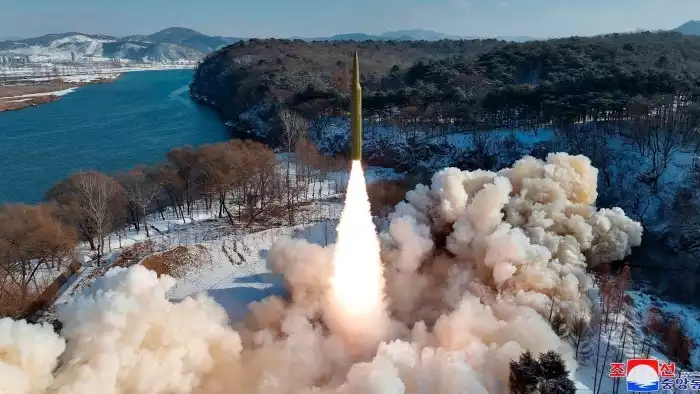Utilizing Solid and Cryogenic Fuel Technology, North Korea recently test-fired a new intermediate-range ballistic missile (IRBM), marking the first instance of such a missile powered by solid fuel with a hypersonic warhead, capable of launching with minimal preparation.
What are Solid Fuel Missiles?
- Solid-fuel missiles are rockets that use a solid propellant, which is a mixture of fuel and oxidizer, packed in a solid cylinder (combustion chamber).
- The fuel and oxidizer are mixed into a fine powder and pressed into a solid cake.
- Once lit, the solid fuel will continue to burn until it is used up.
- Solid rocket engines are used on air-to-air and air-to-ground missiles, on model rockets, and as boosters for satellite launchers.
- The combustion produces more exhaust gas at high temperatures and pressure.
- The amount of exhaust gas that is produced depends on the area of the flame front and a variety of hole shapes can control the change in thrust for a particular engine.
- The hot exhaust gas is passed through a nozzle which accelerates the flow, and thrust is produced according to Newton’s third law of motion.
- Advantages over liquid-fuel missiles:
- There is no need for fueling immediately before launch.
- Easier and safer to operate.
- Require less logistical support.
- They are harder to detect and more survivable.
- It can be stored for an extended period without degrading or breaking down, unlike liquid fuel.
What is Cryogenic Fuel Technology?
- Cryogenic fuels are liquefied gases that are stored at very low temperatures.
- They are used in rocket engines that use cryogenic fuel and oxidizer.
- Cryogenic fuels have a high energy density, but they require advanced insulation for storage and transportation.
- Cryogenic propellants include Liquid nitrogen, Oxygen, Hydrogen, Liquid helium, etc.
- Some rocket engines use regenerative cooling, by circulating their cryogenic fuel around the nozzles before the fuel is pumped into the combustion chamber and ignited
- The Indian Agni and GSLV rockets use liquid oxygen (LOX) and liquid hydrogen (LH2) as cryogenic propellants.
- Advantages of Cryogenic fuels:
- The rocket needs to carry a lesser amount of cryogenic propellants.
- This translates into a higher weight of payload it can carry.
- Liquid propellants provide greater propulsive thrust and power.
Ref: Source
| UPSC IAS Preparation Resources | |
| Current Affairs Analysis | Topperspedia |
| GS Shots | Simply Explained |
| Daily Flash Cards | Daily Quiz |



